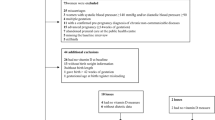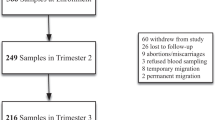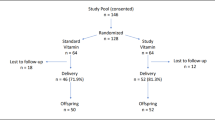Abstract
Objectives: To evaluate periconceptional maternal biochemical and hematological parameters and vitamin profiles in relation to the risk of early pregnancy loss and birth weight.
Design: Prospective longitudinal study.
Setting: University Medical Centre Nijmegen, Academic Medical Centre, Amsterdam, Maria and Elisabeth Hospitals, Tilburg, and Catharina Hospital, Eindhoven, The Netherlands.
Subjects: A cohort of 240 women recruited before pregnancy.
Interventions: Blood samples were taken preconceptional and at 6 and 10 weeks amenorrhea in which the concentrations of hemoglobin, hematocrit, creatinin, uric acid, total protein, serum iron, total iron-binding capacity, ferritin, and the concentrations of retinol, tocopherol, thiamine, riboflavin, pyridoxal-5′-phosphate, cobalamin and folate were analyzed.
Main outcome measures: Risk of early pregnancy loss and birth weight.
Results: The risk of early pregnancy loss increased with increasing prepregnancy weight, and when the periconceptional decline in hematocrit, creatinin and uric acid was less profound (slope: P<0.01). Maternal smoking was negatively associated with birth weight (mean reduction of 183 g, P<0.05). Maternal age and prepregnancy weight were positively associated with birth weight (P<0.01). No significant associations were found between vitamin concentrations and risk of early pregnancy loss or birth weight.
Conclusions: Several periconceptional biochemical parameters are significantly associated with early pregnancy loss. The effects of maternal periconceptional health on embryonic development and subsequent pregnancy outcome should be further explored.
Sponsorship: Dutch Prevention fund, grants no. 28.1358 and 28.1006.
This is a preview of subscription content, access via your institution
Access options
Subscribe to this journal
Receive 12 print issues and online access
$259.00 per year
only $21.58 per issue
Buy this article
- Purchase on Springer Link
- Instant access to full article PDF
Prices may be subject to local taxes which are calculated during checkout

Similar content being viewed by others
References
Açkurt F, Wetherilt H, Löker M & Hacibekiroğlu M (1995): Biochemical assessment of nutritional status in pre- and postnatal Turkish women and outcome of pregnancy. Eur. J. Clin. Nutr. 49, 613–622.
Bailey L (2000): New standard for dietary folate intake in pregnant women. Am. J. Clin. Nutr. 71(Suppl), S1304–S1307.
Bernstein IM, Ziegler W & Badger GJ (2001): Plasma volume expansion in early pregnancy. Obstet. Gynecol. 97, 669–672.
Buschman NA, Forster G & Vickers P (2001): Adolescent girls and their babies: achieving optimal birthweight. Gestational weight gain and pregnancy outcome in terms of gestation at delivery and infant birth weight: a comparison between adolescents under 16 and adult women. Child Care Health Dev. 27, 163–171.
Cikot RJLM, Steegers-Theunissen RPM, Thomas CMG, de Boo TM, Merkus JMWM & Steegers EAP (2001): Longitudinal vitamin and homocysteine levels in normal pregnancy. Br. J. Nutr. 85, 49–58.
Cnattingius S, Bergström R, Lipworth L & Kramer MS (1998): Prepregnancy weight and the risk of adverse pregnancy outcomes. N. Engl. J. Med. 338, 147–152.
Daly S, Mills JL, Molly AM et al (1997): Minimum effective dosed of folic acid for food fortification to prevent neural-tube defects. Lancet 350, 1666–1669.
De Jong CL, Paarlberg KM, van Geijn HP et al (1997): Decreased first trimester uric acid production in future preeclamptic patients. J. Perinat. Med. 25, 347–352.
De Weerd S, Wouters MGAJ, Mom-Boertjens J, Bos KL & Steegers EAP (2001): [Preconception advice: evaluation of an outpatients' clinic at a university hospital]. Ned. Tijdschr. Geneeskd. 145, 2125–2130.
Duvekot JJ, Cheriex EC, Pieters FAA, Menherre PPCA, Schouten HJA & Peeters LLH (1995); Maternal volume homeostasis in early pregnancy in relation to fetal growth restriction. Obstet. Gynecol. 85, 361–367.
Eskenazi B, Fenster L & Sidney S (1991): A Multivariate analysis of risk factors for preeclampsia. JAMA 266, 237–241.
James WPT (1997): Long-term fetal programming of body composition and longevity. Nutr. Rev. 55(Suppl), S31–S43.
Kline J, Stein Z & Susser M (1989): Conception to Birth: Epidemiology of Prenatal Development. New York: Oxford University Press.
Kloosterman GJ (1970): On intrauterine growth. The significance of prenatal care. Int. J. Gynaecol. Obstet. 8, 895–912.
Kramer MS (1987): Determinants of low birth weight: methodological assessment and metaanalysis. Bull. World Health Org. 65, 663–737.
Lincoln R (1986): Smoking and reproduction. Fam. Plann. Perspect. 18, 79–84.
Murphy JF, O'Riordan F, Newcombe RG, Coles EC & Pearson JF (1986): Relation of hemoglobin levels in first and second trimesters to outcome of pregnancy. Lancet 1, 992–995.
Nelen WLDM, Blom HJ, Steegers EAP, den Heijer M, Thomas CMG & Eskes TKAB (2000): Homocysteine and folate levels as risk factors for recurrent early pregnancy loss. Obstet. Gynecol. 95, 519–524.
Nelen WLDM, Steegers EAP, Eskes TKAB & Blom HJ (1997): Genetic risk factor for unexplained recurrent early pregnancy loss. Lancet 350, 861.
Osrin D & Costello AML (2000): Maternal nutrition and fetal growth: practical issues in international health. Semin. Neonatol. 5, 209–219.
Ray JG & Laskin CA (1999): Folic acid and homocysteine metabolic defects and the risk of placental abruption, pre-eclampsia and spontaneous pregnancy loss: a systematic review. Placenta 20, 519–529.
Sibai BM, Gordon T, Thom E et al (1995): Risk factors for preeclampsia in healthy nulliparous women: a prospective multicenter study. Am. J. Obstet. Gynecol. 172, 642–648.
Silver HM, Seebeck M & Carlson R (1998): Comparison of total blood volume in normal, preeclamptic, and non-proteinuric gestational hypertensive pregnancy by simultaneous measurement of red blood cell and plasma volumes. Am. J. Obstet. Gynecol. 179, 87–93.
Soffronoff EC, Kaufman BM & Connaughton JF (1977): Intravascular volume determinations and fetal outcome in hypertensive diseases of pregnancy. Am. J. Obstet. Gynecol. 127, 4–9.
Steegers-Theunissen RPM, Boers GHJ, Blom HJ, Trijbels JMF & Eskes TKAB (1992): Hyperhomocysteinaemia and recurrent spontaneous abortion or abruption placentae. Lancet 339, 1122–1123 (letter).
Steegers-Theunissen RPM, Renier WO, Borm GF et al (1994): Factors influencing the risk of abnormal pregnancy outcome in epileptic women: a multi-centre prospective study. Epilepsy Res. 18, 261–269.
Steegers-Theunissen RPM, Smithells RW & Eskes TKAB (1993): Update of new risk factors and prevention of neural tube defects. Obstet. Gynecol. Surv. 48, 287–293.
Steegers EAP, Thomas CMG, de Boo TM, Knapen MFCM & Merkus JMWM (1999): Klinisch-chemische referentiewaarden in de zwangerschap. Maarssen: Elsevier/ Bunge.
Tamura T, Goldenberg RL, Johnston KE, Cliver SP & Hoffman HJ (1997): Serum concentrations of zinc, folate, vitamins A and E, and proteins, and their relationship to pregnancy outcome. Acta Obstet. Gynecol. Scand. 76, 63–70.
Thame M, Wilks RJ, McFarlane-Anderson N, Bennett FI & Forrester TE (1997): Relationship between maternal nutritional status and infact's weight and body proportions at birth. Eur. J. Clin. Nutr. 51, 134–138.
Acknowledgements
We would like to thank Mr W Lemmens for his assistance in programming, Mrs N Hamelvan Bruggen, Mrs E van de Laak-Schellekens, Mrs W Mathijssen, and Mrs A van de Hurk, research nurses, for the collection of data.
Author information
Authors and Affiliations
Contributions
Guarantor: EAP Steegers.
Contributors: S de W studied the literature, interpreted the data and wrote the report with contributions from all authors. RPM S-T was responsible for recruitment of women, and designed the study together with EAPS TM de B designed the statistical model and carried out the analyses. CMGT developed most of the vitamin assays and takes full responsibility for the accuracy of laboratory measurements and data integrity.
Corresponding author
Rights and permissions
About this article
Cite this article
de Weerd, S., Steegers-Theunissen, R., de Boo, T. et al. Maternal periconceptional biochemical and hematological parameters, vitamin profiles and pregnancy outcome. Eur J Clin Nutr 57, 1128–1134 (2003). https://doi.org/10.1038/sj.ejcn.1601654
Received:
Revised:
Accepted:
Published:
Issue Date:
DOI: https://doi.org/10.1038/sj.ejcn.1601654
Keywords
This article is cited by
-
5-Methyltetrahydrofolate and thiamine diphosphate in cord-blood erythrocytes of preterm versus term newborns
European Journal of Clinical Nutrition (2013)
-
Begin at the beginning: some reflections on future periconceptional and obstetric care and research in the Netherlands
European Clinics in Obstetrics and Gynaecology (2005)
-
Begin at the beginning: some reflections on future periconceptional and obstetric care and research in the Netherlands
European Clinics in Obstetrics and Gynaecology (2005)



